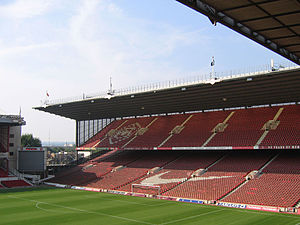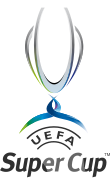Highbury (stadium)
| Highbury | |
|---|---|
| Arsenal Stadium | |

|
|
| The North Stand of Highbury | |
| Data | |
| place |
|
| Coordinates | 51 ° 33 '28 " N , 0 ° 6' 9" W |
| owner | Arsenal Holdings plc |
| opening | September 6, 1913 |
| First game | 6 September 1913 Arsenal FC - Leicester Fosse 2-1 |
| Renovations | 1932-1936, 1992-1993 |
| demolition | May 7, 2006 (closed) |
| surface | Natural grass |
| architect |
Archibald Leitch (1913) CW Ferrier and W. Binnie (1930s conversion) |
| capacity | 38,419 spaces (when closed) 73,000 spaces (1930s) |
| playing area | 100 m × 67 m |
| Societies) | |
| Events | |
|
|
The Highbury (in German-speaking countries also Highbury Stadium ), officially Arsenal Stadium , was an English football stadium that was the home ground of Arsenal FC between 1913 and 2006 . It has since been largely demolished. The stadium was located in the London borough of Islington in the district of the same name and was therefore mainly referred to as Highbury . On the site of the stadium there is now an apartment complex called Highbury Square .
The facility was known for its very small playing field of 100 meters × 67 meters (or 109 yards × 73 yards). The lawn was constantly maintained to an above-average level and had lawn heating . Arsenal FC groundskeeper Steve Braddock had won the Premier League's best groundskeeper of the year title several times because of his good lawn care at Highbury.
The Highbury offered 38,500 spectators (12,500 in the north, 11,000 in the west and 9,000 in the east stand and 6,000 in the clock end called south stand) and was only equipped with seats. There were two large video displays in the southeast and northwest corners. The main entrances were on Gillespie Road, Avenell Road and Highbury Hill. Before all standing room was removed from the stadium, the main crowd was reached in 1935, when the Arsenal FC match against Sunderland FC watched 73,295 spectators.
The 2005-06 season was the last Arsenal FC played at Highbury. The last league game took place on May 7, 2006 against Wigan Athletic . Arsenal won 4-2 in front of 38,359 spectators. In the summer of 2006, the club moved into the new Emirates Stadium some 400 meters away .
history
The original Highbury was built in 1913. At that time, the club, still called Woolwich Arsenal , had left its home in the south-eastern part of London in Plumstead for Highbury and rented sports fields from the local theological college . The stadium, which was designed by the renowned Scottish stadium architect Archibald Leitch , only had an east stand and additional terrace standing places in the other areas. After a series of renovations in the 1930s, there were no significant remnants of the original building left until the demolition.
The first renovation work concerned the west stand, designed by Claude Waterlow Ferrier and William Binnie in a special Art Deco style. It was officially opened in 1932, at the same time as the London Underground station at this point was renamed from Gillespie Road to Arsenal . Leitch's main grandstand was demolished to make way for an east grandstand, which was identical to the west grandstand, which was then completed in 1936 and had a special exterior facade facing Avenell Road. The north and south stands were both covered, with a large clock installed over the latter, which gave the south stand the name Clock End .
The venue more or less remained in this condition for the next 50 years, although the north stand had to be rebuilt due to the great destruction in the Second World War . In 1951, a floodlight system was built that had been advocated by then trainer Herbert Chapman 20 years earlier . The results of the Taylor Report , a kind of requirement profile for the safety in the stadiums after the Hillsborough disaster , then specified that standing in all football stadiums should be converted into seating. The north stand, which until then was home to the club's most passionate supporters, was then torn down in 1992 and replaced by a grandstand with seats. The Clock End grandstand was retained and was merely renovated by adding boxes and seats.
After Arsenal FC moved to the nearby Emirates Stadium in 2006, the stadium was largely demolished and a complex with 700 apartments was built. The listed east stand was included in the construction. In the area of the former playing field there is now a non-public park and a "Memorial Garden", in which the urns of 500 Arsenal supporters are buried.
useful information
In addition to being the permanent home ground for Arsenal FC, the stadium was also used for twelve English national team games between 1920 and 1961 , primarily for friendly matches. This included the famous Battle of Highbury , when the English team defeated the reigning world champions from Italy 3-2 in 1934 and had seven Arsenal players in their ranks. Highbury was also used as a neutral seat for twelve FA Cup semi-finals between 1929 and 1997.
Arsenal FC did not always play at Highbury. During the Second World War the stadium was used to protect civilians from the air raids (as a so-called ARP station ) and was bombed at that time. Arsenal played at the White Hart Lane stadium used by local rivals Tottenham Hotspur at the time , until Highbury Stadium reopened in 1946. Between 1999 and 2000, Arsenal played its Champions League games at Wembley Stadium , as capacity was already very limited and this would have been further reduced by the additional seats required for advertising purposes. Arsenal's statistics with only two games won out of six games then ensured that the club returned to the local Highbury after two years.
Numerous cricket and baseball games have also been played at Highbury . In 1966 the world heavyweight championship fight between boxers Henry Cooper and Muhammad Ali took place there, which Ali won.
The Highbury has appeared in several films and served as the backdrop for the movies The Arsenal Stadium Mystery and Fever Pitch .
The stadium was also called "Highbury the Library" ( German Highbury the library ). This is due to the quiet Arsenal fans, so it was very quiet at the Highbury during the games by English standards. This continues in the current Emirates Stadium.
gallery
Web links
- Stadium history on the website of FC Arsenal (English)
- Arsenal Stadium (Highbury )
- Information on stadiumguide.com (English)
- Highbury Square ( Memento of October 4, 2013 in the Internet Archive )
Individual evidence
- ^ A b Marcus Theurer: Unusual living: At home in the stadium . FAZ.net . February 21, 2010. Retrieved February 22, 2010.
- ↑ mirrorfootball.co.uk: Arsene Wenger attacks quiet Arsenal fans for making Emirates new library (English)
- ↑ shoot.co.uk: Arsenal fans too quiet! ( Memento from November 15, 2011 in the Internet Archive ) Article from October 11, 2011 (English)






